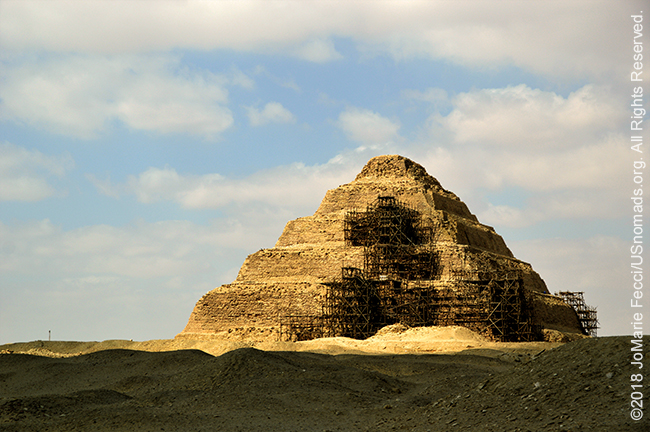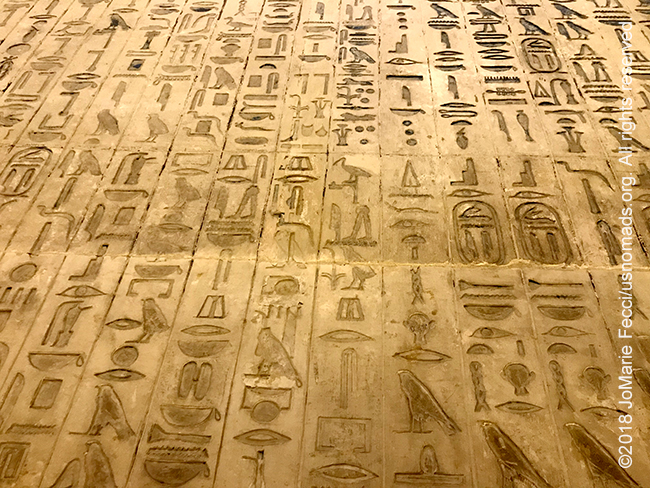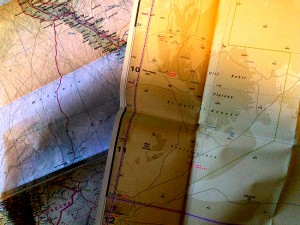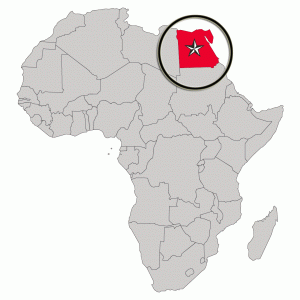
SAQARRA, EGYPT (30 March 2018) — Driving south from Cairo towards Memphis, the first capital of Egypt, we followed the line of an irrigation canal that in some places was dammed up by garbage while in other spots people in small boats were engaged in something I hoped was not fishing. A few dead animals could also be seen half submerged in the murky water. We were clearly not in Cairo anymore, but it was hard to tell when we actually “left” the limits of the city.
The towns we were passing through seemed poorer and more agrarian, and I was surprised when we arrived to the site of Memphis on the outskirts of Mit Rahina. The idea that the great ancient capital was beside a backwater town seemed incongruous. Some shadow of the greatness should have remained, but it didn’t. Only the artifacts survived.
A massive and beautifully carved statue of Rameses II lay at the center of a room built expressly to house it with a viewing platform one story above. The smoothly polished stone face looked regal and peaceful, like a sleeping giant, unaware of what had become of his kingdom outside.
Several other artifacts from the archeological site were on display around the garden which was ringed by the stands of souvenir sellers. Most prominent was a Sphinx in the center of the promenade. Unlike “the” Sphinx of Giza, this one still had his face on and Nahla explained to me that Sphinxes were actually common in ancient Egyptian tradition, as they represented one of the forms of “Ra” — the sun god. Understanding the concept of “Ra” was not so simple. Though a single god, he had several forms and they corresponded to the time of day (or more precisely, to the position of the sun in the sky) and each form had a different representation. According to the belief, Ra sailed across the heavens during the day in his boat called the “Barque of Millions of Years.” In the morning when Ra emerged from the east, his boat was named, “Madjet” which meant “becoming strong.” By the end of the day the boat was called, “Semektet” which meant “becoming weak.” At the end of the day, it was believed that Ra died and sailed on to the underworld. Ra was reborn at dawn the very next day.
The morning manifestation of Ra is Khepri the scarab. Ra of Midday is usually depicted in the shape of a man with a falcon head. The evening manifestation of Ra is the ram-headed god Khnum. Sphinxes associated the pharaoh to the primeval sun and creator god.
From Memphis we headed towards the vast necropolis at Saqarra, where the first pyramid was built. As we approached the step pyramid was visible on the horizon, framed by a scaffolding that gave the odd impression that it was just being built now. It made me think about the irony of the fact that the technology they were using to restore these monuments was less developed then the technology used to originally build them. I wondered to myself how we could just “lose” all that knowledge. I mean, whomever built these pyramids didn’t do it alone, so the knowledge and skill was widespread enough and dispersed amid an army of workers for centuries. How does that “disappear”? Was there some kind of “purge” by one of the conquering civilizations that wiped out the people and their knowledge too?
Known as the Pyramid of Djoser (the Pharaoh buried there), it dominates the desert where it stands like a mountain towering above the sprawling funerary complexes that surround it. The wind was blowing very lightly across the open expanse of sand in front of the pyramid, and a few other tourists were exploring the area as locals with camels, donkeys and horses waited respectfully around the edges offering visitors a chance to pose with the animals for a photo near the edifice.
The necropolis is still very much an active archeological excavation site, though a number of areas are open to the public including one of the many smaller pyramids that seems to be crumbling back into the desert. I took the opportunity to go down into the burial chamber to see what it was like, though I hadn’t yet understood the “system” of “guides” who lead you down the steep planks into the darkness repeating “watch your head, watch your head” as you walk bent over, invariably hitting your head at some point anyway.
Alternating between feeling the mystery of the pyramids and feeling like a silly Indiana-Jones-Tomb-Raider wanna-be, I followed the guide with his flashlight into the chamber where the sarcophagus goes. The flashlight was enough to illuminate the walls covered in hieroglyphics, with a star patterned ceiling above. It was eerie and magical and a little weird to be “touring” someone’s grave. Yet I was fascinated by the entire elaborate complex of rituals and the little we know about this culture that was so obsessed with the “afterlife” that they spent the majority of their lives and wealth preparing for it.

ABOUT THE EXPEDITION

JoMarie Fecci, of USnomads, sets off on an independent scouting trip across Egypt and Sudan in preparation for an up-coming Sahara expedition. Driving locally-sourced Toyotas and working with small local teams in each region, she will traverse a winding route that jumps off from key points along the Nile as far south as Khartoum, where the Blue and White Niles meet. During the journey she will visit a series of UNESCO world heritage sites focused on the ancient civilizations that occupied the region and meet with local communities. The primary goal of this mission is to assess terrain, security, driving conditions, logistical concerns and approximate timeframes for future travel.
WHERE WE ARE

The Arab Republic of Egypt, is a transcontinental country spanning the northeast corner of Africa and southwest corner of Asia by a land bridge formed by the Sinai Peninsula. With the Mediterranean sea on its northern border, the Gulf of Aqaba to the east, and the Red Sea to the east and south, it occupies a geo-strategic location connecting Europe, Asia and Africa. It has land borders with Gaza and Israel to the east, Sudan to the south, and Libya to the west. Islam is the official religion and Arabic the official language. Egypt is the most populous country in North Africa and the Arab world, with over 95 million inhabitants. Most of the population lives near the banks of the Nile River, in an area of about 40,000 square kilometres (15,000 sq mi), where the only arable land is found. The large regions of the Sahara desert, which constitute most of the country’s territory, are sparsely inhabited. Considered a cradle of civilization, Egypt emerged as one of the world’s first nation states in the tenth millennium BC and iconic monuments such as the Giza Necropolis and its Great Sphinx, as well the ruins of Memphis, Thebes, Karnak, and the Valley of the Kings, reflect this legacy.